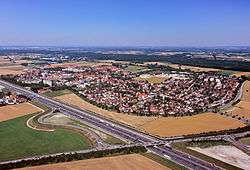Garching bei München
| Garching bei München | ||
|---|---|---|
|
Garching | ||
| ||
 Garching bei München | ||
| Coordinates: 48°15′N 11°39′E / 48.250°N 11.650°ECoordinates: 48°15′N 11°39′E / 48.250°N 11.650°E | ||
| Country | Germany | |
| State | Bavaria | |
| Admin. region | Upper Bavaria | |
| District | Munich | |
| Government | ||
| • Mayor | Dietmar Gruchmann (SPD) | |
| Area | ||
| • Total | 28.16 km2 (10.87 sq mi) | |
| Elevation | 481 m (1,578 ft) | |
| Population (2015-12-31)[1] | ||
| • Total | 16,812 | |
| • Density | 600/km2 (1,500/sq mi) | |
| Time zone | CET/CEST (UTC+1/+2) | |
| Postal codes | 85748 | |
| Dialling codes | 089 | |
| Vehicle registration | M | |
| Website | Official website | |
Garching bei München or Garching is a city in Bavaria, Germany near Munich. It is the home of several research institutes and university departments. It became a city on 14 September 1990.
Location
The town is at 48°15′N 11°39′E / 48.250°N 11.650°E, near the River Isar and the A9 autobahn.
Garching has a number of scientific research institutes and scientific experiment facilities located in the city, including a linear accelerator and a research nuclear reactor. The nuclear research reactor, nicknamed Atomei (nuclear egg) appears in the city's coat of arms, and started the process leading to an accumulation of research institutes. A number of roads and places in the city are named after scientists, mathematicians and technical innovators, including "Carl-Von-Linde-Strasse", "Dieselstrasse", "Einsteinstrasse", "Eulerweg", "Heisenbergstrasse", "Max-Planck-Strasse", "Röntgenstrasse", "Schrödingerweg".
Districts
The town has four districts:
- Garching
- Dirnismaning
- Hochbrück
- Hochschul- und Forschungszentrum (University and Research Centre) - formerly known as Forschungsinstitute (Research Institutes)
Transport
The Munich U-Bahn metro line 6 connects the city with the stations Garching-Hochbrück, Garching and Garching-Forschungszentrum.
Educational and research institutes

Several research and scientific educational institutions are based in Garching, including:
- Departments of the Technical University of Munich (TUM)
- physics
- FRM-II research reactor
- semiconductor physics and engineering (Walter Schottky Institute)
- chemistry
- mechanical engineering
- mathematics
- computer science
- Max Planck Institutes:
- Max Planck Institute for Astrophysics (MPA)
- Max Planck Institute for Extraterrestrial Physics (MPE)
- Max Planck Institute for Plasma Physics (IPP)
- Max Planck Institute for Quantum Optics (MPQ)
- Max Planck Computing and Data Facility (MPCDF)
- Part of the physics department of the Ludwig-Maximilians-Universität
- Headquarters of the European Southern Observatory (ESO)
- ESO Supernova Planetarium & Visitor Centre at ESO Headquarters
- Federal Research Institute for Food Chemistry (Deutsche Forschungsanstalt für Lebensmittelchemie; DFA)
- Walther Meißner Institute (WMI) of the BAdW (low-temperature physics)
- Bavarian Center of Applied Energy Research (ZAE)
- Reactor safety research
- General Electric Global Research Center
- Leibniz-Rechenzentrum of the BAdW (central computing facilities for the Munich universities and other research institutes)
- BMW M GmbH - high-performance/motorsport vehicle research and development
International relations
Garching bei München is twinned with:
Sport
The town's football club VfR Garching, formed in 1921, experienced its greatest success in 2014 when it won promotion to the Regionalliga Bayern for the first time.
References
- ↑ "Fortschreibung des Bevölkerungsstandes". Bayerisches Landesamt für Statistik und Datenverarbeitung (in German). June 2016.
External links
| Wikimedia Commons has media related to Garching bei München. |
- http://www.garching.de/ (Official Town Website)

